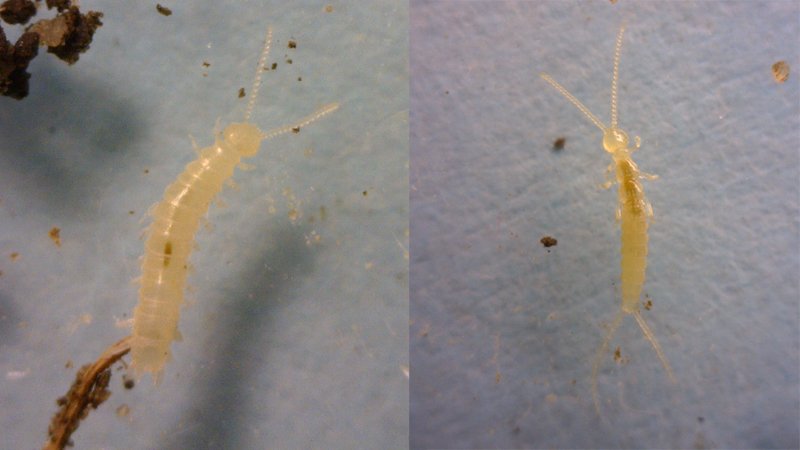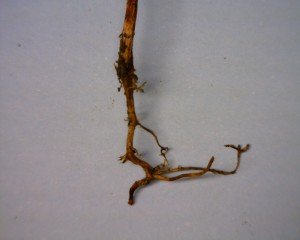An investigation into poor establishment in a field of cotton west of Dalby this week confirmed the presence of the soil dwelling symphyla as the likely cause.
Symphylans are relatively common in most soils where they generally feed on decomposing organic matter.
Symphyla as crop pests
Identification of the symphylans collected from the Theodore region confirmed that the species present was not the exotic Scutigerella immaculata, but an endemic Hanseniella species. Limited records suggest that this genus has been responsible for occasional economic damage to pineapple and sugarcane crops in Queensland. Scutigerella immaculata is a serious pest of various vegetable crops in other parts of the world and was detected several years ago in Victoria and NSW.
Symptoms of symphyla activity
Affected plants from fields in Theodore exhibited wilting symptoms despite the good soil moisture, and general stunting. Seedling death was also observed in patches. Inspection of affected plant root systems revealed stunted development and in many cases the cessation of tap root development and subsequent root branching that is referred to as “witches’ broom”.
Following the suspected problems with symphyla on cotton in Theodore, the Toowoomba QDAFF Entomology group conducted a basic pot study with seedling cotton and confirmed that symphyla would indeed feed on developing roots and cause the same seedling stunting and mortality as had been observed in the field.
Sampling for symphyla
The distribution of symphylans in fields is generally patchy, making sampling for them prior to planting difficult. At this stage little is know about the most effective sampling technique or the density at which symphyla are likely to cause establishment losses.
Symphyla can be detected by conducting a basic soil survey. Insert a shovel to full depth at the plant line on the hill and carefully lever the soil out so that it can be inspected more closely. Symphyla are delicate creatures so care must be taken not to overly compact the soil while sampling. Start with the soil from the bottom of the shovel, as symphyla are more common in the deeper, wetter part of the soil profile. Holding a soil clod in one hand, use your other hand to careful break the soil apart while keeping a close eye on the inner surfaces for the movement of symphyla. Symphyla are fast moving and will rapidly shift to avoid sunlight.
It is important not to confuse symphyla with other soil creatures such as diplura or collembola (springtails). Diplura closely resemble symphyla but are distinguishable by their smaller size, more rapid movement and having legs confined to the upper body. Symphylla have legs along the entire body and lack the long appendages at the end of the diplura’s abdomen. Collembola are more easily distinguished from symphyla having more of a curved body and the capacity to jump when disturbed.

A symphylan (left) is very similar in appearance to a dipluran (right), but has legs all along its body like a millipede and lacks the dipluran’s long rear appendages.
Control and management
Currently there are no chemical control options for symphyla that can be recommended. When symphylans are prevalent, in-furrow treatments of insecticide at planting will not provide sufficient protection as the plant establishes and roots grow past the treated zone. As symphyla are active to depths of up to one metre it is difficult to target this pest with insecticide.
At Theodore this pest has been partly managed by ensuring that susceptible fields are planted last so that the warmer conditions aid rapid establishment. Plant health is monitored closely and once establishing plants show any signs of moisture stress (and symphyla are present) a quick flush with irrigation is conducted to aid plant development so that the crop ultimately out-grows the pest. Typically symphyla feed on the roots where the soil is moist. As the profile dries out, this continuous pruning of the roots can leave plants stranded in the top 10-15cm of soil upon an otherwise full profile.
If symphyla are found to be abundant in affected fields (4 to 6 individuals per shovel full of soil) and establishment is poor enough to warrant replanting, consider planting an alternate crop such as maize or sorghum that are reportedly less susceptible than a tap rooted crop. Replant cotton in another field if possible.
Symphyla will be the subject of recently commenced research that will aim to better understand this pest’s ecology and how it might be more effectively sampled and managed.
In the interim if you have fields that are experiencing unexplained patches of seedling mortality, wilting or reduced crop vigour, dig some soil to see if symphyla are a cause.
See how symphyla look and move, and the damage to cotton seedlings:

